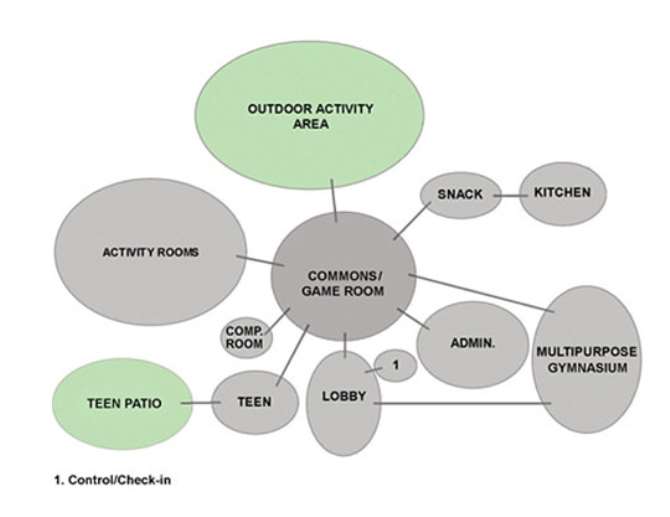Importance of Building a Youth Center in Nigeria and What Our Politicians Must Do…

Building a youth center as part of youth development is an ongoing growth process in which the community engages to help youth meet their basic personal and social needs to be safe, feel cared for, be valued, be useful, be spiritually grounded, and to build skills and competencies which allow them to function and contribute in their daily lives.
In the absence of positive influences, youth will find other ways, often negative ones like gangs, to meet their needs. Forty years of youth development research shows that at-risk youth can become successful in spite of the odds they face. There are five basic supports and opportunities that youth need in order to overcome obstacles in their homes, schools and communities
1. Emotional and Physical Safety. Meeting youth’s basic needs as well as building trust and respect.
2. Caring Relationships from at least one adult in each youth’s life, and the existence of positive relationships with peers.
3. Youth Participation. Includes opportunities for youth to have a voice, multiple choices, leadership, a say in decision-making and a sense of belonging.
4. Community Involvement. Opportunities for the youth to connect and impact their community in positive ways.
5. Skill building that is challenging, relevant and engaging across a core set of competencies (cognitive, social, vocational, civic, physical and creative/cultural)
Why invest in youth development?
For the last four decades, our nation has been trying to resolve youth problems – academic failure, drug use, teen pregnancy, juvenile crime, lack of workforce readiness and more. Youth “problems” are often caused by underlying issues that are widespread and chronic: persistent poverty, parents’ lack of family management skills, tribalism, lack of supports and opportunities, and lack of clear standards in the community. As a result, many youth experience difficulties in school, have poor navigation and decision making skills, lack of a sense of purpose and lack of skills or access to affect change. Even when “problems” are addressed, youth are not automatically then prepared for college, work and life.
Low voter turnout and low volunteer rates are signs that youth do not understand their civic obligations. Youth must be prepared appropriately so they can respond to the challenges and opportunities of navigating adolescence and preparing for adulthood.
What is the impact on our workforce if we do not invest in youth development?
- Insecurity
- Militancy and terrorism increases, especially BOKO HARAM
- Deficits in basic skills cost businesses across Nigeria
- Family stresses such as poverty and social isolation
- Juvenile crime increases
HOW TO BUILD A YOUTH CENTER
- Form a board of directors Hold a public meeting to raise interest in starting a center. Invite local community advocates as well as community leaders. Form a group to work as a team to set up your youth center
- Create a mission statement and goals .Have your board of directors write down the purpose and goals of the youth center. Figure out the needs of the community and find solutions to help the local youth
- File for non-profit status. Contact the Internal Revenue Service about becoming a non-profit organization. This will allow you to fundraise as a charity, receive donations to run your programs, and make your organization exempt from federal income tax
- Find a facility. Find a building for your operation. You'll need the space to support your planned activities and to meet your goals. Also factor in location, costs and safety when choosing a place
- Recruit volunteers and eventually hire staff. Recruit dedicated, reliable people to volunteer at your center. As soon as your youth center has a steady income, hire paid and trained qualified employees. Keep your staff happy and feeling like they are a meaningful part of the team.
- Fundraise. Solicit funds from corporations, government agencies and individuals from community, state and federal sources. Hold events to raise funds to run your youth center.
FINANCING BY GOVERNMENT FUNDING
1. Youth programs must be funded and supported by numerous agencies at the federal, state, and local levels. These agencies must have their own purposes, targets, eligibility requirements, application processes, and reporting procedures
2. Legislatures, House of Assembly members, House of Representatives members and Senators must build youth centers as part of their constituency project
FINANCING BY PUBLIC-PRIVATE PARTNERSHIP
What is a public-private partnership?
A public-private partnership exists when the public sector—federal, tribal, state, or local officials and agencies—joins with the private sector—families, employers, citizens, philanthropies, the media, civic groups, service providers, and community-based organizations— to pursue a common goal.
Public-private partnerships for youth programs typically focus on ways to improve and expand the capacity of schools, neighborhoods, communities, service providers, or the state to meet the needs of young people and their families.
All effective public-private partnerships share these characteristics.
Representatives from the public and private sectors coalesce around shared goals.
The partners contribute time, money, expertise, or other resources to the partnership.
The partners work together toward common goals or objectives.
The partners share decision-making and management responsibilities. Although these four characteristics are shared, the goals, structure, and organization of partnerships vary widely. For example, the types and amounts of resources contributed by the partners will differ according to ability. Similarly, the extent of shared decision making will depend on the resources and constraints of the various partners, such as technical expertise, fundraising capability, potential conflicts of interest, legal responsibility for the oversight of public funds, and other considerations.
YOUTH CENTERS BUILDING DESIGN
The Center supports must support opportunities for youth to develop their physical, social, emotional, and cognitive abilities and to experience achievement, leadership, enjoyment, friendship, and recognition.
The Youth Center must be designed to offer organized instructional programs for physical activities such as dance, yoga, and martial arts and for academic and arts programs such as science, crafts, and theater. It also offers opportunities for unstructured activities such as game playing, socializing, club meetings, and outdoor play
BUILDING DESIGN OF A YOUTH CENTER
- SPACE AND BUILDING ORGANIZATION
A Youth Center serves the dual purpose of accommodating unstructured social interaction among different age groups and providing instructional classes all in a safe, supervised environment.
Typical Youth Center activity spaces include the following:
- Control desk/check-in
- Commons/game room
- Snack bar
- Activityrooms/classrooms
- Multipurposeroom/gymnasium
- Computer room
- Outdoor activity areas.
Typical Youth Center support spaces include the following:
- Administrative office space
- Toilets
- Kitchen and
- Mechanical/electrical/communications space.
It is particularly effective to organize the activity spaces around the common room, making it the heart of the program area around which the other program spaces revolve. The commons area is the principal social gathering point and fulfills many of the social interaction goals of the facility. It usually includes subareas such as a game area, an eating area (adjacent to the snack bar), a television (TV) viewing area, and general gathering/conversation spaces. These subareas should accommodate social units of 12 to 15 youth gathering in pockets.
The commons should naturally "grow" out of the lobby, past the control desk. The control desk should have visual control over the entire Commons and any entrances to other spaces. The entrances to the other activity spaces should be well defined and act as portals to those areas.
The activity rooms can range from small classroom spaces to a full-sized gymnasium, depending on facility mission, programs offered, and available budget. Typically at least two activity rooms should be provided: one configured for more academic or arts and crafts instruction and one configured for physical activities.
A computer room provides the youth with supervised computer and Internet access for recreation and homework purposes.
.
B. DESIGN CONSIDERATIONS
Key design goals and considerations for Youth Centers include the following:
CREATE A HOMELIKE ENVIRONMENT
While meeting the durability requirements for a public facility, the finishes, furnishings, fixtures, and equipment in Youth Centers should be comfortable and have a homelike quality:
- Provide ample naturallight
- Provide a sense of welcome and arrival at the entrance, lobby, and control desk
- Use residential-style doors and windows
- Use indirect lighting as main ambient lighting, and
- Avoid institutional, unnatural finishes, textures, and colors.
ENCOURAGE CREATIVITY
Part of the facility's mission is to encourage creative development. The project development process and final design can help accomplish this in several ways:
- Carefully consider interior colors and textures. Design the Youth Center to communicate a sense of fun, but use restraint (e.g., neutral tones for backgrounds and ceilings, with warm colors for accents).
- Provide space and consider various techniques to display and celebrate youth artwork, and
- Design display areas to be easily changed and updated, minimize permanent graphics.
ENCOURAGE AUTONOMY
Youth centers are not schools. While supervision must be maintained at all times, the design should accommodate autonomy in the unstructured activity areas. The youth patrons should have independent access to the following:
- Snack bar and toilets
- Games, computers, and TV
- Friends and companions, and
- Quiet space for solitude.
INCLUDE APPROPRIATE SPACE FOR STAFF
Provide space to assist staff in developing and maintaining the center's programs and business. Outside of normal day-to-day operations, staff must be able to accomplish the following:
- Think and plan
- Meet and communicate
- Host visitors, and
- Store equipment and records
MAINTAIN A SAFE AND HEALTHY ENVIRONMENT
Design the facility to accommodate equipment and operational strategies to both protect the youth and maintain a healthy environment . Consider the followingcritical elements:
- Prevent unauthorized access by potentially dangerous personnel
- Provide visual access to all spaces to monitor potential child abuse situations
- Provideeasily-cleaned finishes
- Use non-toxic building materials and improved maintenance practices
- Ensure good indoor air quality and abundant natural light, and
- Ensure that equipment, furnishings, and finishes do not contain asbestos or lead
CONCLUSION
The rewards of a properly run youth center outweigh the risks. Youth centers will reduce Nigerian youth’s involvement in Boko Haram activities, reduce unemployment, reduce crime rate and encourage entrepreneurship.
Serious nations that have plans for youth development build youth centers and its benefits cannot be over emphasized as can be seen in countries like Sweden, United Kingdom, Germany, Japan, Canada, Australia, United States, Denmark etc
Nigerian politicians, political leaders, Governors and even the Presidency should build youth centers across the nation. It does not take Rocket science to do this. It will be more beneficial for our nation than to engage our youths in thuggery votes buying, social media bullying and other societal vices that have taken our nation many steps backward
Ohamadike–Dunukofia
9th December, 2018. Stockholm, Sweden

